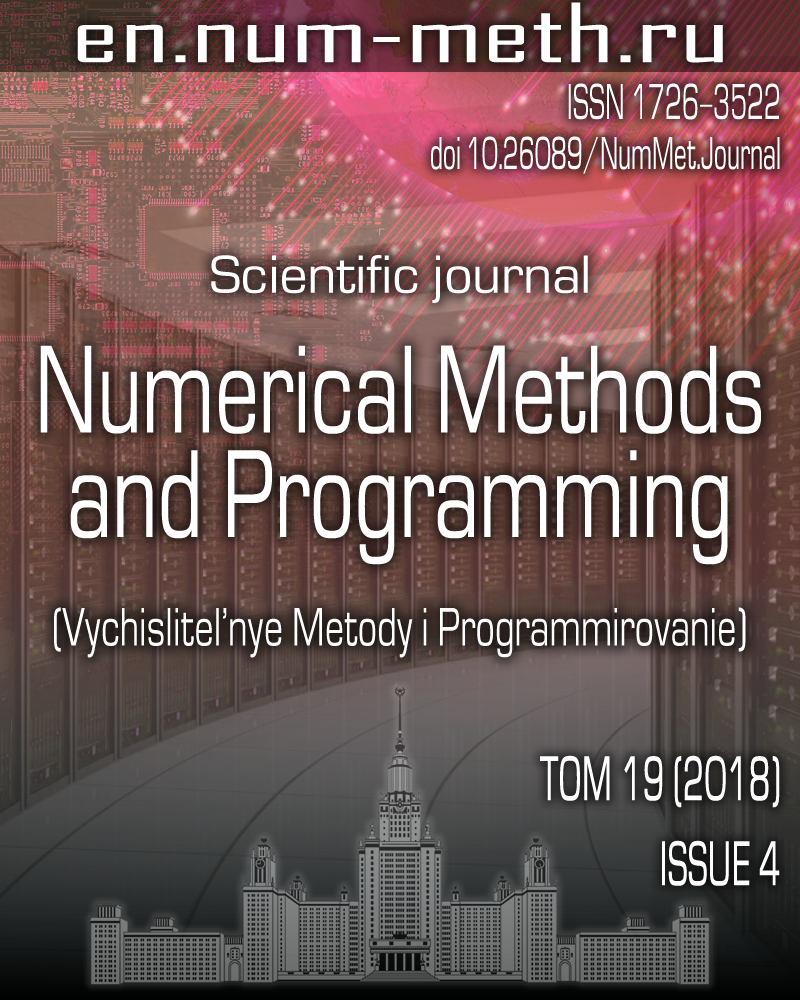DOI: https://doi.org/10.26089/NumMet.v19r430
Modeling the division of biological cells in the stage of metaphase on the «Lomonosov-2» supercomputer
Keywords:
Abstract
This paper is devoted to the construction of a mathematical model for a biological cell to describe the process of its division during the $M$-phase. We propose a refinement for one of the well-known models by extending it from two-dimensional to three-dimensional case. The modified model is implemented as an universal software package for modeling the cell division in the stages of prometaphase, metaphase, and anaphase on workstations and supercomputers. Using this software and the «Lomonosov-2» supercomputer, we study the relation between the size of the kinetochore active area and the number of merotelic attachments in the metaphase. It is shown that the observed correlation is not a result of geometric constraints, as it was earlier assumed, but is an effect of large rotation angles of chromosome pairs.
Published
Issue
Section
References
- A. V. Zaytsev and E. L. Grishchuk, “Basic Mechanism for Biorientation of Mitotic Chromosomes is Provided by the Kinetochore Geometry and Indiscriminate Turnover of Kinetochore Microtubules,” Mol. Biol. Cell 26 (22), 3985-3998 (2015).
- B. Alberts, A. Johnson, J. Lewis, et al., Molecular Biology of the Cell (Garland Science, New York, 2002).
- D. O. Morgan, The Cell Cycle: Principles of Control (Sinauer Associates, Sunderland, 2006).
- J. Gregan, S. Polakova, L. Zhang, et al., “Merotelic Kinetochore Attachment: Causes and Effects,” Trends Cell Biol. 21 (6), 374-381 (2011).
- N. R. Gliksman, R. V. Skibbens, and E. D. Salmon, “How the Transition Frequencies of Microtubule Dynamic Instability (Nucleation, Catastrophe, and Rescue) Regulate Microtubule Dynamics in Interphase and Mitosis: Analysis Using a Monte Carlo Computer Simulation,” Mol. Biol. Cell 4 (10), 1035-1050 (1993).
- F. Nédélec, “Computer Simulations Reveal Motor Properties Generating Stable Antiparallel Microtubule Interactions,” J. Cell Biol. 158 (6), 1005-1015 (2002).
- G. W. Brodland and J. H. Veldhuis, “Computer Simulations of Mitosis and Interdependencies between Mitosis Orientation, Cell Shape and Epithelia Reshaping,” J. Biomech. 35 (5), 673-681 (2002).
- D. Gerlich, J. Beaudouin, B. Kalbfuss, et al., “Global Chromosome Positions Are Transmitted through Mitosis in Mammalian Cells,” Cell 112 (6), 751-764 (2003).
- R. Wollman, E. N. Cytrynbaum, J. T. Jones, et al., “Efficient Chromosome Capture Requires a Bias in the ’Search-and-Capture’ Process during Mitotic-Spindle Assembly,” Curr. Biol. 15 (9), 828-832 (2005).
- I. V. Gregoretti, G. Margolin, M. S. Alber, and H. V. Goodson, “Insights into Cytoskeletal Behavior from Computational Modeling of Dynamic Microtubules in a Cell-Like Environment,” J. Cell Sci. 119 (22), 4781-4788 (2006).
- R. Paul, R. Wollman, W. T. Silkworth, et al., “Computer Simulations Predict that Chromosome Movements and Rotations Accelerate Mitotic Spindle Assembly without Compromising Accuracy,” Proc. Natl. Acad. Sci. USA 106 (37), 15708-15713 (2009).
- A. Mogilner, R. Wollman, G. Civelekoglu-Scholey, and J. Scholey, “Modeling Mitosis,” Trends Cell Biol. 16 (2), 88-96 (2006).
- J. R. McIntosh, M. I. Molodtsov, and F. I. Ataullakhanov, “Biophysics of Mitosis,” Q. Rev. Biophys. 45 (2), 147-207 (2012).
- G. Civelekoglu-Scholey and D. Cimini, “Modelling Chromosome Dynamics in Mitosis: A Historical Perspective on Models of Metaphase and Anaphase in Eukaryotic Cells,” Interface Focus 4 (2014).
doi 10.1098/rsfs.2013.0073 - M. A. Krivov, N. Yu. Zakharov, F. I. Ataullakhanov, and P. S. Ivanov, “Development of Software for Modeling Cell Division on Graphics Accelerators,” in Proc. Int. Conf. on Russian Supercomputing Days, Moscow, Russia, September 26-27, 2016 (Mosk. Gos. Univ., Moscow, 2016), pp. 582-588.


